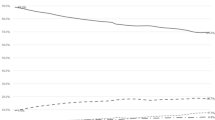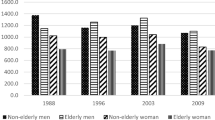Abstract
Different patterns of single-parent and two-parent families in six major expenditure categories are examined using the 1989 Consumer Expenditure Survey. Comparisons are made of the influence of permanent income, family size, region, race, gender, age, and education of the head of the family on the expenditure categories. The results show that with the exception of expenditures on shelter, the two groups differ significantly in their consumption patterns.
Similar content being viewed by others
References
Abdel-Ghany, M., & Schwenk, F. N. (in press). Functional forms of household expenditure patterns in the United States.Journal of Consumer Studies and Home Economics.
Boyle, M. (1989). Spending patterns and income of single and married parents.Monthly Labor Review, 112(3), 37–41.
Carliner, G. (1973). Income elasticity of housing demand.Review of Economics and Statistics, 55, 528–532.
Chow, G. (1960). Test of equality between sets of coefficients in two linear regressions.Econometrica, 28, 591–606.
Epstein, M. F. (1979). Children living in one-parent families.Family Economics Review, 1979 (Winter), 21–23.
Horton, S., E., & Hafstrom, J. (1985). Income elasticities for selected consumption categories: Comparison of single female-headed and two-parent families.Home Economics Research Journal, 13, 292–303.
Lee, F., & Phillips, K. E. (1971). Differences in consumption patterns of farm and non-farm households in the United States.American Journal of Agricultural Economics, 53, 573–582.
Lino, M. (1989). Financial status of single-parent households.Family Economics Review, 2(1), 2–7.
Lino, M. (1990). Factors affecting expenditures of single-parent households.Home Economics Research Journal, 18, 191–201.
U.S. Department of Commerce. (1990).Statistical abstract of the United States: 1990, (110th edition). Washington, DC: U.S. Government Printing Office.
U.S. Department of Labor. (1991).Consumer expenditure survey: 1989, interview survey public use tape and documentation. Washington, DC: Bureau of Labor Statistics.
Weiss, R. S. (1984). The impact of marital dissolution on income and consumption in single-parent households.Journal of Marriage and the Family, 46, 115–127.
Author information
Authors and Affiliations
Additional information
1991 Visiting Professor at the Family Economics Research Group, Agricutural Research Service, U.S. Department of Agriculture. Current research interests include consumption economics and time-use allocation.
Current research interests include the economic status of American households.
Rights and permissions
About this article
Cite this article
Abdel-Ghany, M., Schwenk, F.N. Differences in consumption patterns of single-parent and two-parent families in the United States. J Fam Econ Iss 14, 299–315 (1993). https://doi.org/10.1007/BF01013982
Issue Date:
DOI: https://doi.org/10.1007/BF01013982




